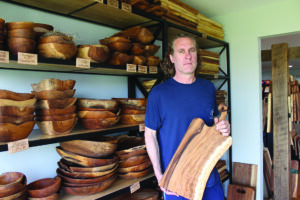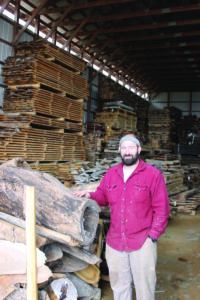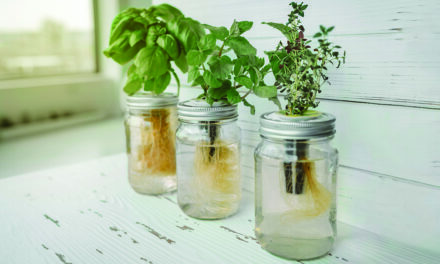
George Dent’s Tuckahoe Hardwoods launched its live edge collection about six years ago and includes bowls, serving boards, coasters, vases and trays. (Photo by Sean Clougherty)
Making anything out of wood takes tools and plenty of hand work to reach a finished product. Local woodworkers add maintaining a live edge aesthetic to projects also relies on a higher power.
Having part of the piece, whether it’s a cutting board, a desk or counter top, keep the silhouette of the tree it was sawn from as a live edge, remains popular according to local woodworkers.
It brings an element of nature into a home and since no two trees are the same, each piece has a uniqueness all its own.
“God created it, we just finish it,” said Dave Boyle, owner of Wood Ingenuity in Queen Anne, who specializes in tables and furniture using large trees, many that come from the Eastern Shore.
Boyle said many customers come to him thinking they need black walnut or maple for their project based on popular trends but when they peruse his inventory or slabs, shape and style often come before species.
“They find one that kind of speaks to them,” he said.
Many slabs come with historical provenance of where the tree grew locally — some for 250 to 350 years, which Boyle said appeals to customers.
While Boyle focuses on project that can set off an entire room, Tuckahoe Hardwoods in Easton zeroes in on smaller items that add a flourish of nature in any living space.
Started in 2004 by brothers George and Johnny Dent, Tuckahoe Hardwoods launched its live edge collection about six years ago and includes bowls, serving boards, coasters, vases and trays.
As the pandemic kept people in their homes, people used their kitchens more for and wanted to add items that both brought a bit of nature inside and improved the quality of the food preparation experience.
As the pandemic subsided, in-home entertaining took off, and people continued to seek attractive items, leading many to live edge, George said.
“It follows the shape of the tree,” he added. “It makes each piece original. No two pieces can be alike.”
George said East Indian Walnut — also known as rain tree — is their preferred species in the live edge collection.
It’s plentiful in tropical areas, harvested sustainably and its distinct wood grain builds on the aesthetic.
It’s often lighter sapwood at the live edge provides a nice contrast with the darker heartwood, he said.
“People love nature and it’s very organic and has a natural feel,” George added. “Nature is the artist. We’re not

After about 10 years of sawing logs from old, often enormous trees, Dave Boyle has amassed an extensive inventory for live edge furniture pieces. (Photo by Sean Clougherty)
the artist.”
For Boyle, projects for commercial spaces like restaurant tables and bar tops were the bulk of his business before the pandemic, but during and after, it’s flipped to about 80 percent residential.
Desks are popular as more people migrated to working from home and wanted to improve their new main workspace.
Vanities, butcher blocks, kitchen islands and counter tops also rank high on people’s wish list.
“It’s always a focal point, whether it’s a mantle, a dining room table, or the first thing you see in the kitchen.
Boyle said he generally recommends removing bark from the live edge.
It helps rid the piece of any bugs that could still be in the wood and is easier to keep clean.
From there, he said preserving the live edge comes with a lot of handwork — sanding and any fine tuning.
“I’m just cleaning it up enough to get finish on it.”
For Boyle, the hardest part can be getting the often-huge tree transported and unloaded at his mill.
Some logs reach four feet in diameter, he said.
But, he added, it seems pretty easy to build excitement around the aesthetic.
“I think it will always be strong,” Boyle said of live edge’s popularity. “It’s a generational thing, I think.”





